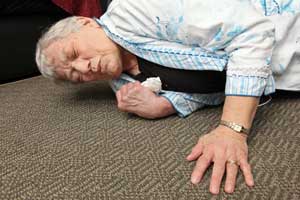Phlebotomists are integral members of the laboratory team and often patients' only contact with the laboratory. As such, their attitude and actions color patients' feelings toward the laboratory. Not only do phlebotomists have a huge impact on patients' perceptions of the laboratory, but they are the front line when it comes to patient safety issues such as sample quality and identification.
But thinking outside the box when it comes to patient safety can lead to some surprising results. This is a story of how a non-traditional partnership between our phlebotomy team at Emory University Hospital in Atlanta and the nursing staff led to a decrease in patient fall rates, a major safety problem in hospitals.
Impact of Hospital Falls
Falls are the most common adverse event reported in hospitals, with more than one million hospital inpatients falling each year (1). Head trauma and fractures are among the most serious complications, often resulting in longer hospital stays, litigation, and increased healthcare costs. To bring attention to this problem, the federal government in 2008 eliminated payments to hospitals for costs associated with treating fall-related injuries (2).
Yet, even with the intense governmental pressure and concentrated local efforts, hospitals still struggle to develop effective strategies that decrease fall rates.
Assessing Patients' Fall Risk
Numerous factors have been associated with increased risk of falling, including advanced patient age, a documented history of falling, certain medications, insecure bedrails, impaired balance and cognition, and even the unit where a patient is located. Consequently, a number of tools have been developed to assess a patient's risk.
Our hospital assesses fall risk at the time of admission using the Morse Fall Scale. This scale accounts for recent fall history, gait, balance, and presence of an ambulatory aid such as crutches or a walker. Interestingly, when reviewing 2012 fall data, staff noticed an increase in patient fall rates that coincided with early morning phlebotomy collections. An analysis revealed that when patients were awakened for sample collection, they often stayed awake and attempted to use the restroom unassisted or wanted to watch television and fell reaching for the remote.

Could a phlebotomist have prevented this fall? The surprising answer is yes!
Unlikely Partners Team Up
Based on this analysis, the nursing staff decided to enlist the help of the phlebotomy team to decrease fall rates. Working with the various clinical teams, the phlebotomists developed unit-specific, phlebotomy-driven interventions for units deemed high-risk for patient falls.
The teams quickly realized that it was important to develop unit-specific strategies because falls occur for a variety of different reasons. On some units, they decided that it was best for the phlebotomists to call ahead so that the nurses could offer the patient assistance, thereby minimizing the opportunity for a patient to get up independently.
In other units, phlebotomists were trained to look for standard, institutional fall risk signs before entering patients' rooms. For these high-risk individuals, phlebotomists developed a special routine that involved specifically asking patients if they needed to use the restroom after collecting the specimen. For patients who do, the phlebotomist notifies a nurse and waits to ensure the patient gets the required assistance.
Fall Prevention Strategies Used by Phlebotomy
- Ask if the patient needs to use the restroom.
- Check that bedrails and furniture on wheels are locked in position.
- Place TV remote control, phone, eyeglasses, etc. within easy reach for the patient.
- Check that the bed is in the low position.
- Check the floor and clear pathway to restroom.
Driving Change and Adding Value
Successfully implementing a program like this can be challenging and may require changes in measuring staff performance. For example, the extra time it takes to ensure a patient is safe may decrease the productivity of an individual phlebotomist. Given how daily workload varies, some phlebotomists also may find it challenging to give the floor a phone call 10–15 minutes before arriving. Phlebotomists will need to display patience and flexibility when waiting for a nurse to arrive, which also can delay collecting other patient samples and finishing their rounds. In our experience, metrics designed to assess meaningful system goals, rather than optimizing individual phlebotomy goals, have been key to the collaboration's success.
The phlebotomy team has willingly embraced this new role in our organization. Teaming up with patients and nursing staff to improve patient safety has brought real value to the fall prevention program and initial results suggest a decreasing fall rate.
One phlebotomist said this new procedure has given her greater ownership of the patient's safety while she is in the room. She says she feels greater responsibility for the patient's well-being and now double checks the bed height and railing as part of her routine. Another described how the addition of the fall question to her process has led patients to ask for personal belongings such as a book or remote control, a request that could prevent a fall.
All agree that the new process has certainly been successful in improving patient-phlebotomist interactions. We think this is a great example of how non-traditional, interdepartmental partnerships are adding value to patient safety initiatives.
REFERENCES
- Currie L. Fall and injury prevention. In: Hughes RG, ed. Patient safety and quality: An evidence-based handbook for nurses. Rockville, Md.: Agency for Healthcare Research and Quality 2008.
- Inouye SK, Brown C, Tinetti M. Medicare nonpayment, hospital falls, and unintended consequences. NEJM 2009;360:2390–3.

Emily Ryan, MD, is a clinical chemistry fellow in Pathology and Laboratory Medicine at Emory University School of Medicine, Atlanta.
Email: [email protected]

Corinne R. Fantz, PhD, DABCC, is associate professor of Pathology and Laboratory Medicine at Emory University School of Medicine, Atlanta, and a member of the Patient Safety Focus Editorial Advisory Board.
Email: [email protected]